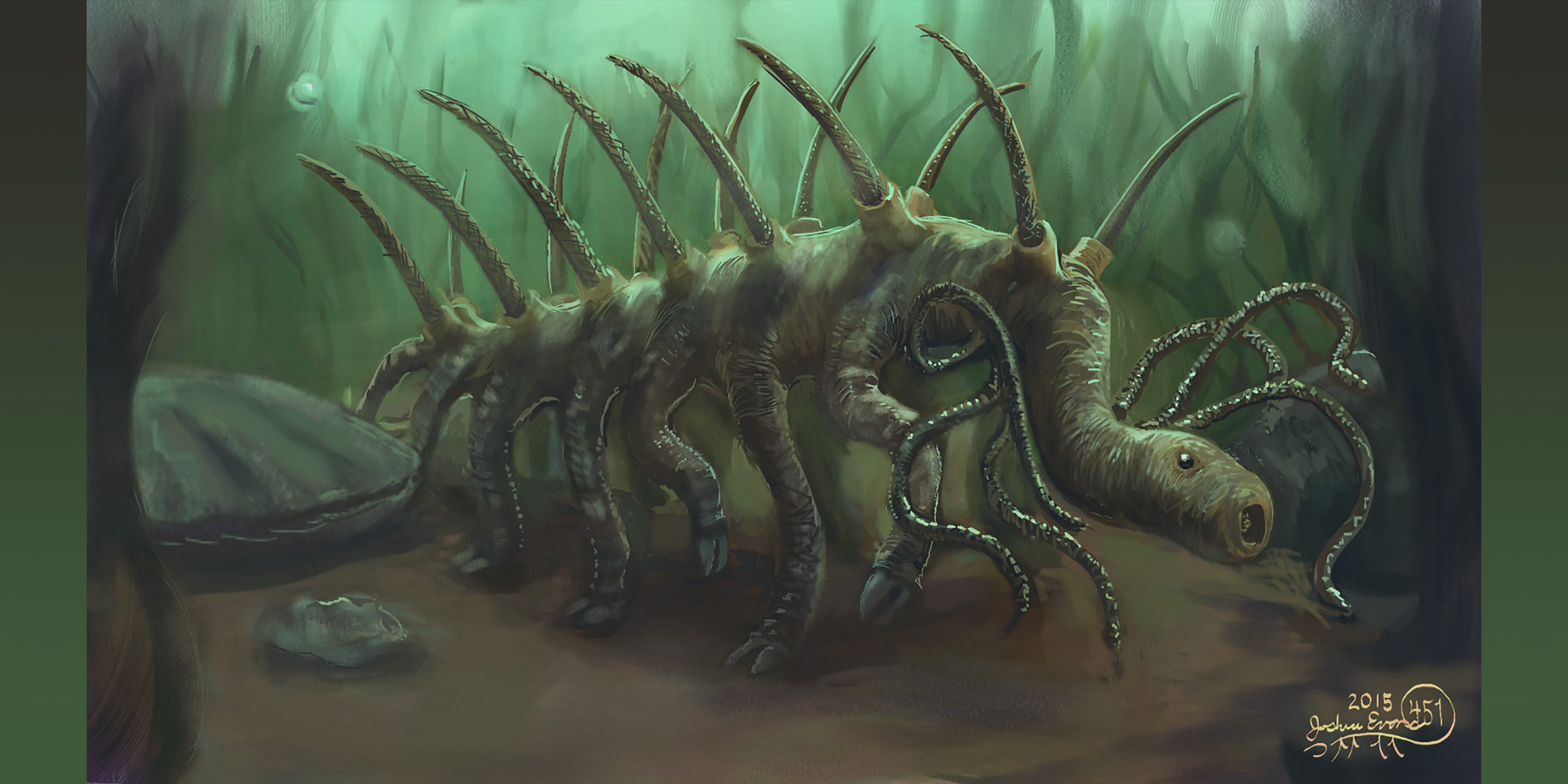Originally published 17 June 1991
This is the tale of topsy-turvy Hallucigenia, a little animal that doesn’t know which way is up. It is also a tale of scientific riddles and how they are solved.
One of the biggest unsolved riddles in science is the Cambrian Explosion.
Ever since Darwin’s time, anti-evolutionists have made much of so-called “missing links.” Their argument goes like this: If all present life descended from earlier life by a sequence of tiny changes or mutations, then creatures representing every step in the progression should appear in the fossil record. But there are gaps. For example, the first bird, Archaeopteryx, appears out of nowhere, without a feathered ancestor. Proving that evolution is false.
Or so say Creationists. But in fact, Archaeopteryx is a rather convincing missing link. It shares feathers and fused clavicles (wishbone) with modern birds. It shares a small brain, long tail, separated hand bones, and non-expanded sternum with reptiles of its time. For evolutionists, Archaeopteryx fits comfortably into the story of change by natural selection.
The greatest of all supposed gaps in the fossil record — and the favorite missing link of Creationists — occurred at the beginning of the Cambrian period of geologic history.
Explosion of creatures
For 3 billion years before the Cambrian only microscopic, single-celled creatures inhabited the Earth. Then, quite suddenly, between 600 and 500 million years ago, the oceans were swarming with new kinds of creatures — sponges, trilobites, brachiopods, mollusks, jellyfish, and, indeed, the ancestors of nearly all forms of life existing today, plus many other creatures without modern progeny. Paleontologists call this sudden proliferation of life the Cambrian Explosion.
Why did it happen?
Evolutionists are not certain. They ponder the riddle of the Cambrian Explosion and look to nature for the answer.
Creationists say the fossil animals and plants of the Cambrian Explosion are products of the fifth and sixth days of Creation, buried in sediments at the time of the Deluge.
By fixing themselves so firmly in theological blinders, Creationists cut themselves off from one of the best scientific detective stories of all time. What is worse, by pressuring state legislatures and textbook publishers to downplay or delete evolution from school curricula, they seek to deprive American school children of a chance to enjoy the riddle and its solution.
Which brings us to Hallucigenia, a little inch-long animal of Cambrian seas.
The original specimens of Hallucigenia were found 82 years ago in the Burgess shale quarry of Western Canada. Until recently, the Burgess shale was the best of the few known sites on Earth where soft-bodied Cambrian flora and fauna have been preserved. Hallucigenia is surely the strangest animal of Cambrian seas. A reconstruction of the animal by British paleontologist Simon Morris appears in Stephen Jay Gould’s recent book, Wonderful Life: The Burgess Shale and the Nature of History.
In Morris’s reconstruction, Hallucigenia stands on seven pairs of thorn-like spikes, perhaps adapted to climbing on sponges. A single row of flexible tentacles runs along Hallucigenia’s back, perhaps offering separate passages to the animal’s gullet. It is not clear which end of the animal is head and which is tail.
Hallucigenia “is really weird,” writes Gould, adopting the kids’s vernacular. The animal’s name was chosen by Morris to emphasize the weirdness.
In 1984, another trove of beautifully preserved Cambrian fossils was discovered in south China. Although half-a-world away from the Burgess shale quarry, the new animals have many affinities with their Canadian cousins.
Turned upside down
In a [May 1991] issue of Nature, L. Ramsköld and Hou Xianguang, of the Swedish Museum of Natural History and the Nanjing Institute of Geology and Paleontology, describe a caterpillar-like creature from the South China trove that turns the conventional view of Hallucigenia upside down.
The new animal has anatomical similarities with Hallucigenia. But this time the state of preservation is such that what had seemed to be a single row of tentacles on the back of Hallucigenia are now are interpreted as a double row of legs. And the spikes that Morris thought were appendages adapted for climbing on sponges are now interpreted as defensive armor.
So which way is up for Hallucigenia? Did the little beast walk on stiff stilts, stabbing them into the soft bodies of sponges? Or, as the new fossils suggest, did it present its spikes defensively to the world like the spines of a hedgehog?
The answer will not come by theological fiat, but by patiently examining the rocks of western Canada, south China, and anywhere such fossils can be found, and — most importantly — by being open to whatever surprises nature has in store.
That’s how science works, and that’s how the riddle of the Cambrian Explosion will be solved. Every new fossil discovery fills a gap in our knowledge. Every new fossil helps bridge the missing links.
Any animal as weird as spiky Hallucigenia should be part of every schoolchild’s knowledge of life. It’s a shame that children should be deprived of such marvelous examples of the diversity of Creation by those who use the gaps in our knowledge as proofs of the Creator.



